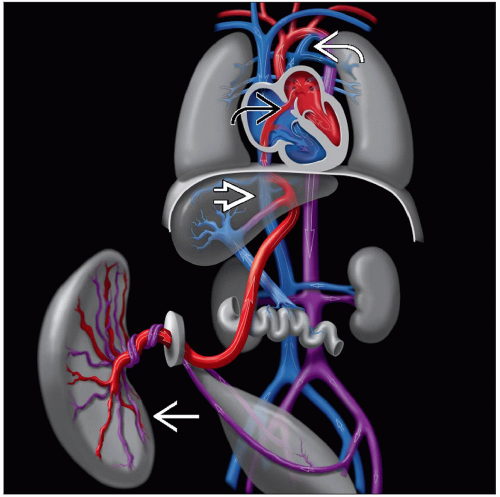Persistent Pulmonary Hypertension
Larissa V. Furtado, MD
Key Facts
Terminology
Persistent pulmonary hypertension of newborn (PPHN)
Etiology/Pathogenesis
Failure of pulmonary circulation to transition from a high- to low-pressure system at birth
High pulmonary vasculature resistance prevents adequate pulmonary blood flow and perfusion leading to hypoxemia, acidemia, and lactic acidosis
Not completely understood
Multifactorial
Clinical Issues
Most frequently occurs in term or near-term neonates
Microscopic Pathology
Peripheral extension of smooth muscle and circumferential muscularization of pulmonary arterioles
 Gas exchange is primarily performed by the placenta in utero. Lungs are bypassed due to high pulmonary vascular resistance. Oxygenated blood from the placenta
 reaches the heart via the ductus venosus & inferior vena cava reaches the heart via the ductus venosus & inferior vena cava  & enters the left atrium through the foramen ovale & enters the left atrium through the foramen ovale  . Blood flows to the aorta from the left ventricle or via ductus arteriosus . Blood flows to the aorta from the left ventricle or via ductus arteriosus  , & only 5-10% of cardiac output reaches the lungs. At birth, systemic vascular resistance increases, lung vascular tone decreases, & pulmonary perfusion starts. Failure of the pulmonary circulation to make this transition at birth results in persistent pulmonary hypertension. , & only 5-10% of cardiac output reaches the lungs. At birth, systemic vascular resistance increases, lung vascular tone decreases, & pulmonary perfusion starts. Failure of the pulmonary circulation to make this transition at birth results in persistent pulmonary hypertension.Stay updated, free articles. Join our Telegram channel
Full access? Get Clinical Tree
 Get Clinical Tree app for offline access
Get Clinical Tree app for offline access

|